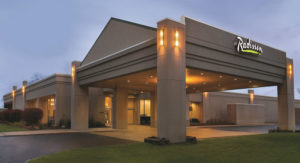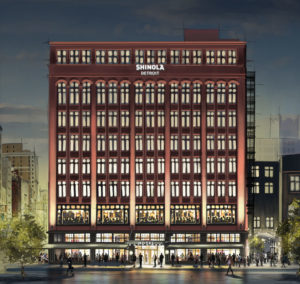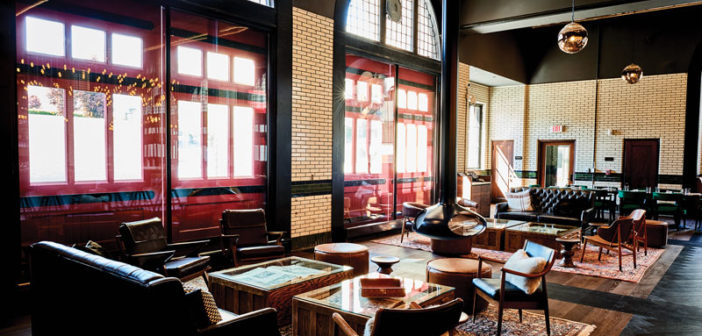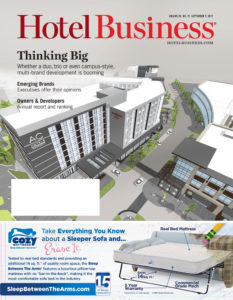DETROIT—With regard to RevPAR growth by year-end 2017, the Motor City’s hotel market continues to outperform U.S. growth within the same performance metric. According to CBRE’s most recent Hotel Horizons report (the June-August 2017 edition), while there’ll be an increase in RevPAR in 2018, the expected growth will be a lot smaller compared to the year prior. ADR growth and occupancy in the area is expected to fall after 2017.
“Our model estimates growth in demand on Moody’s Analytics forecasts of macroeconomic factors such as employment CPI and GDP,” said Mark Eble, managing director for CBRE Hotels’ Consulting. “Forecasts of occupancy ADR and RevPAR also take into account expected changes in supply and the historic relationships of these metrics.”
Detroit hotels are forecast to see a RevPAR increase of 4.7% by year-end 2017, according to CBRE’s report. An increase in occupancy of 0.9% and a gain of 3.7% in ADR is expected to contribute to the rise in RevPAR in 2017. The national RevPAR increase projection during the same time period is 3%.
“The spread between the forecasted RevPAR growth of Detroit versus the U.S. is around 40 basis points,” he explained. “Over the last five years, Detroit has outperformed the U.S. growth in RevPAR by about 100 basis points. Some of this is distorted by the fact that Detroit’s RevPAR fell harder and deeper in 2009 than the U.S.”
The city’s lower-priced segment will lead RevPAR growth in 2017 (with an expected increase of 5.1%). Properties in the lower-priced segment are projected to attain a 4.2% gain in ADR (moving it to $79.38 from $74.23) and see a 0.9% increase in occupancy (jumping to 66%). Supply is expected to increase by 2.2% and demand by 3.1%.
The Motor City’s upper-priced hotels will see an occupancy of 67% in 2017, a slight increase from the year prior. ADR is expected to increase by 3.1% and RevPAR will see a gain of 4.2%. Supply is forecast to increase by 2.8% and demand by 3.8%.
“As household family disposable income is increasing, more families are traveling to the area,” said Asad Malik, CEO & president at Amerilodge Group, a Bloomfield Hills, MI-based developer. “The revitalization of Detroit is also attracting leisure travel into the market.”

Radisson Hotel Detroit Metro Airport opened earlier in the year following a multimillion-dollar modernization of the entire property.
Detroit’s visitor base is mostly made up of several different segments: corporate individuals, corporate groups and associations, and those visiting friends/relatives. “We’ve got 19 million visitors coming to Detroit this year,” said Michael O’Callaghan, EVP/COO at Detroit Metro Convention & Visitors Bureau. “That number is up from about 13 million at the beginning of the decade.”
Not all markets within the city are the same; breaking numbers down into submarkets gives another view. “As with politics, all markets are local,” Eble explained. For example, take Livonia and Southfield (the former is the historically leading market in terms of RevPAR growth and the latter is the lagging market). The historical spread in RevPAR growth between the two is more than 120 basis points. “Looking at the pipeline numbers, it is easier to be optimistic about adding 1,100 rooms (10.7% increase) to the Dearborn submarket, which had a 2016 occupancy of 62%, than adding 760 rooms to Southfield (a 16% increase), which recorded a 63% occupancy in 2016,” he said.
“While Detroit is expected to slightly outpace the nation, forecasts of RevPAR for the next five years for both Detroit and the U.S. are expected to be roughly half the levels of 2012-2016,” he said. “The unusually high growth (in Detroit and nationally) over the last five years was, at least, partially related to the depth of the 2008-2009 recession. I understand that our model includes an allowance for the risk of a recession during the next five years.”
Top upper-priced brands in the market include Marriott (2,866 rooms), Courtyard (1,719), Westin (1,245 rooms), Hilton Garden Inn (976 rooms) and Embassy Suites (880 rooms). Top lower-priced brands include the following: Extended Stay America (1,700 rooms), Red Roof Inn (1,444 rooms), Comfort Inn (1,138), Quality Inn (1,119 rooms) and Days Inn (901 rooms). Total room supply in the city is around 42,852 rooms.
Many challenges with regard to development in the city are related to municipalities impeding the process. “Common issues developing in Detroit are getting the township or city to be better partners in providing overall economic growth in the region,” Malik said. “Labor shortages, wages and benefits are increasing faster than revenue. At times, as the developer is trying to maintain the schedule to open the hotel where there are certain inspects that need to be completed, there’s delay from the township or city.”
Another concern of his is the increase in supply in Detroit’s hotel market. “We are starting to see an oversupply of hotel rooms in the Detroit market as new hotels are coming online. This will put pressure on occupancy levels,” he said. “Also labor shortages, which is increasing costs and which will, in turn, present a risk for profitable hotel investment.”

Shinola and Bedrock Real Estate are working together to open a 130-plus-room boutique hotel in downtown Detroit in 2018.
With regard to the Detroit supply pipeline, there are 20 upper-priced properties in total, 44 lower-priced properties in total and two unclassified/independent properties in total.
In agreement with Malik’s assessment of Detroit market challenges, Ron Wilson, CEO of Hotel Investment Services Inc., a property management company based in Troy, MI, added, “Most markets have major brand critical mass now, and good sites are waning.” He also noted the need of a 500-800-room convention hotel to “complement the improvements to Cobo Hall and the existing Marriott Renaissance Center Hotel.”
Another factor, as with many markets across the country, is that Airbnb is growing. Between June 2016 and June 2017, the total number of entire place listings in Detroit increased by 25% and RevPAR for entire place grew by 9%. Abigail Long, press liaison officer at AirDNA, a Denver-based analytics company that tracks the daily performance of Airbnb listings across the country, told Hotel Business, “When the growth in the number of listings is greater than the growth of RevPAR, it could be argued that this is a sign that the Airbnb market is certainly growing, but that it is starting to show signs of saturation.”
According to the Hotel Horizons report, Detroit RevPAR is expected to grow by 2.5% in 2018. Supply is forecast to increase by 2.2% in the same year; demand is projected to rise by 3.1%. The market’s occupancy levels are expected to range from 65% to 66.4% during the five-year forecast period.
“With moderate growth in demand and RevPAR, the industry is expected to focus on keeping hotels competitive via renovations and training,” Eble noted about the future. “Revenue management will continue to be the most important function in a hotel.”
According to Malik, the outlook on growth isn’t an optimistic one overall. “The Detroit hotel market has seen significant growth over the past four years, and the trends for growth is starting to plateau primarily due to new hotel rooms coming into the market.”
“As long as oil stays in or around its current price, people will continue to buy high-profit trucks and SUVs and the big three automakers, and their supply chain, will have a positive and lasting impact on hotel demand in the greater Detroit market,” Wilson said. HB


